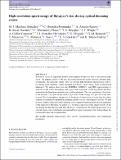High-resolution spectroscopy of Boyajian's star during optical dimming events
Abstract
Boyajian’s star is an apparently normal main-sequence F-type star with a very unusual light curve. The dipping activity of the star, discovered during the Kepler mission, presents deep, asymmetric, and aperiodic events. Here we present high-resolution spectroscopic follow-up during some dimming events recorded post-Kepler observations, from ground-based telescopes. We analyse data from the HERMES, HARPS-N, and FIES spectrographs to characterize the stellar atmosphere and to put some constraints on the hypotheses that have appeared in the literature concerning the occulting elements. The star’s magnetism, if existing, is not extreme. The spots on the surface, if present, would occupy 0.02 per cent of the area, at most. The chromosphere, irrespective of the epoch of observation, is hotter than the values expected from radiative equilibrium, meaning that the star has some degree of activity. We find no clear evidence of the interstellar medium or exocoments being responsible for the dimmings of the light curve. However, we detect at 1–2σ level, a decrease of the radial velocity of the star during the first dip recorded after the Kepler observations. We claim the presence of an optically thick object with likely inclined and high impact parameter orbits that produces the observed Rossiter–McLaughlin effect.
Citation
Martínez González , M J , González-Fernández , C , Asensio Ramos , A , Socas-Navarro , H , Plaza , C W , Boyajian , T S , Wright , J T , Cameron , A C , González Hernández , J I , Holgado , G , Kennedy , G M , Masseron , T , Molinari , E , Saario , J , Simón-Díaz , S & Toledo-Padrón , B 2019 , ' High-resolution spectroscopy of Boyajian's star during optical dimming events ' , Monthly Notices of the Royal Astronomical Society , vol. 486 , no. 1 , pp. 236-244 . https://doi.org/10.1093/mnras/stz850
Publication
Monthly Notices of the Royal Astronomical Society
Status
Peer reviewed
ISSN
0035-8711Type
Journal article
Description
Financial support from the Spanish Ministry of Economy and Competitiveness through projects AYA2014-60833-P, AYA2014-60476-P, and AYA2017-86389-P are gratefully acknowledged. MJMG and JIGH also acknowledge financial support through the Ramón y Cajal fellowship. GMK is supported by the Royal Society as a Royal Society University Research Support Fellow.Collections
Items in the St Andrews Research Repository are protected by copyright, with all rights reserved, unless otherwise indicated.

